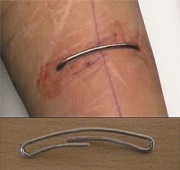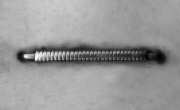Flesh Stapling
Flesh Stapling is an attempt to achieve an aesthetic similar to pocketing (where the middle of the jewelry, rather than the ends, is exposed), but with a dramatically increased chance of healing. This was done by combining the designs of pocketings and surface bars, resulting in a closed staple shaped piece of jewelry. It was invented by Samppa of Mad Max in the 1990s.
First generation Flesh Staples were wire, and positioned using a piercing technique which left two unnecessary holes. Second generation Flesh Staples are flat, similar to flesh plating, still, however, resembling staples. The technique is carried out using a scalpel and skin elevator. Results and appearance have proven to be much more enhanced than the previous generation of stapling.

